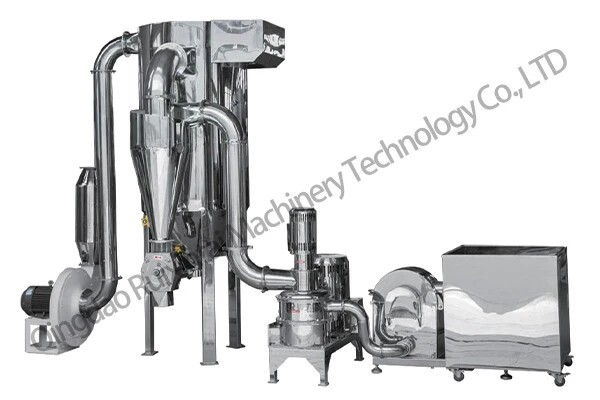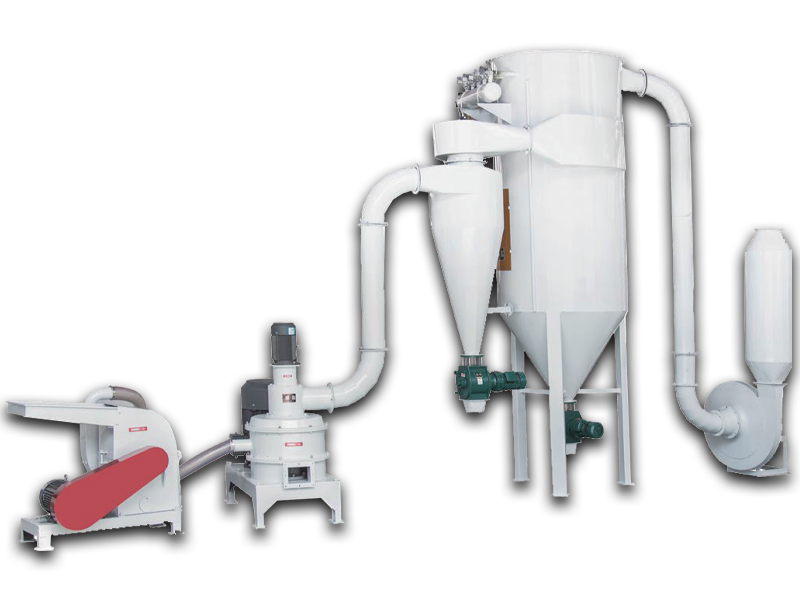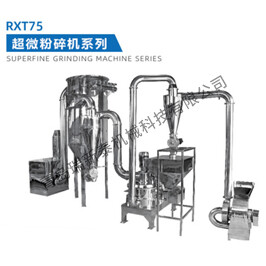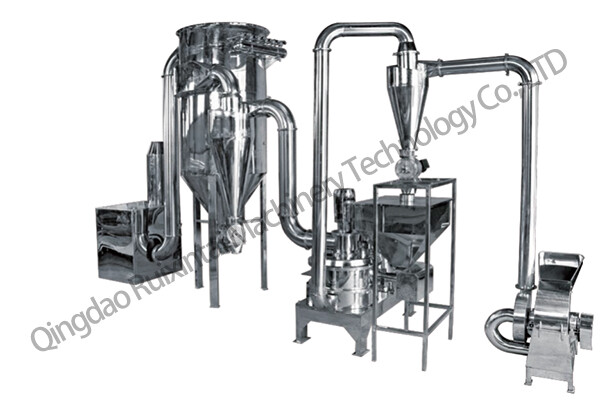RELATED
MESSAGE
Pharmaceutical pulverizers are essential pieces of equipment in the pharmaceutical industry, used for grinding, crushing, and pulverizing raw materials into fine powders. These powders are then used in the production of medicines, ensuring consistency and accuracy in dosage forms. However, operating such machinery comes with its own set of risks and challenges. To ensure the safety of operators and maintain the integrity of the materials being processed, it is crucial to follow strict safety measures.
As a leading pulverizer manufacturer, Ruixintai is committed to providing not only high-quality equipment but also comprehensive guidelines to ensure safe operation. In this article, we will discuss the safety measures that should be followed when operating pharmaceutical pulverizers, helping to minimize risks and ensure optimal performance.
Understanding the Importance of Safety in Pulverizer Operations
Pharmaceutical pulverizers operate at high speeds and involve complex mechanisms, making them potentially hazardous if not handled properly. Safety is paramount to prevent accidents, protect operators, and ensure the quality of the final product. Below are some key reasons why safety measures are critical:

- Operator Protection: Preventing injuries from moving parts, electrical hazards, and material spillage.
- Product Integrity: Ensuring the processed material remains uncontaminated and meets pharmaceutical standards.
- Equipment Longevity: Proper usage and maintenance can extend the lifespan of the pulverizer.
Regulatory Compliance: Adhering to safety standards and guidelines set by regulatory bodies like FDA and OSHA.
precision millingangelica pulverizer
powder processing equipmenttraditional chinese medicine pulverizer rxt75
fine powder grindingpurple sweet potato pulverizer
industrial milling machinepotato pulverizer
precision millingtraditional chinese medicine pulverizer rxt30
high efficiency pulverizer
Key Safety Measures for Operating Pharmaceutical Pulverizers
1. Operator Training
One of the most critical safety measures is ensuring that all operators are adequately trained. At Ruixintai, we emphasize the importance of comprehensive training programs for all personnel handling pulverizers. Operators should understand the machine's functionality, its components, and the potential risks involved. Training should cover:
- Machine startup and shutdown procedures
- Emergency stop mechanisms
- Maintenance and cleaning protocols
- Handling raw materials and finished products
Regular refresher courses should also be conducted to keep operators updated on the latest safety practices.
2. Pre-Operation Inspection
Before starting the pulverizer, it is essential to conduct a thorough inspection of the machine. This helps identify any potential issues that could lead to accidents or equipment failure. Key areas to check include:
- Electrical connections and wiring
- Moving parts and mechanical components
- Lubrication levels
- Filters and screens
- Safety guards and covers
At Ruixintai, we recommend using a pre-operation checklist to ensure no critical steps are overlooked.
3. Use of Personal Protective Equipment (PPE)
Operators should always wear appropriate personal protective equipment (PPE) when working with pharmaceutical pulverizers. This includes:
- Safety goggles or face shields to protect against dust and debris
- Gloves to prevent contact with hazardous materials
- Hearing protection to reduce noise exposure
- Respirators or masks to prevent inhalation of fine particles
- Protective clothing to minimize skin contact
Ruixintai advises all operators to ensure their PPE is in good condition and fits properly before starting any operation.
4. Proper Material Handling
The raw materials used in pharmaceutical production can vary in texture, density, and chemical composition. Mishandling these materials can lead to contamination, equipment damage, or even health risks. To ensure safety:
- Store materials in designated areas to prevent cross-contamination
- Follow material handling guidelines provided by the manufacturer
- Use appropriate tools for loading and unloading materials
- Avoid overloading the pulverizer, as this can strain the motor and other components
At Ruixintai, we provide detailed material handling instructions tailored to each pulverizer model.
5. Installation of Safety Guards
All pharmaceutical pulverizers should be equipped with safety guards to protect operators from moving parts. These guards act as barriers, preventing accidental contact with rotating blades, belts, or gears. Ruixintai ensures that all our pulverizers come with robust safety guards that meet industry standards. Additionally, operators should:
- Never remove or bypass safety guards
- Regularly inspect guards for damage or wear
- Replace damaged guards immediately
Proper use of safety guards significantly reduces the risk of injuries during operation.
6. Emergency Stop Mechanisms
Every pulverizer should be equipped with an easily accessible emergency stop button or switch. This allows operators to quickly shut down the machine in case of an emergency, such as equipment malfunction or material blockage. Ruixintai designs its pulverizers with strategically placed emergency stop mechanisms to ensure rapid response during critical situations.
7. Routine Maintenance and Cleaning
Regular maintenance and cleaning are essential for the safe and efficient operation of pharmaceutical pulverizers. Neglecting these tasks can lead to equipment failure, contamination, or safety hazards. Key maintenance activities include:
- Inspecting and replacing worn-out parts
- Cleaning the machine to remove residue and buildup
- Lubricating moving parts to reduce friction
- Calibrating the machine to ensure accurate performance
Ruixintai provides detailed maintenance schedules and guidelines for all our pulverizer models, helping clients keep their equipment in top condition.

8. Monitoring and Supervision
Continuous monitoring of pulverizer operations is crucial to identify and address issues promptly. Supervisors should oversee the process and ensure that all safety protocols are being followed. Ruixintai recommends the use of automated monitoring systems to track machine performance and detect anomalies in real-time.
9. Adhering to Regulatory Standards
Pharmaceutical companies must comply with strict regulatory standards to ensure product quality and safety. Pulverizer operators should be familiar with guidelines from organizations such as:
- Food and Drug Administration (FDA)
- Occupational Safety and Health Administration (OSHA)
- Good Manufacturing Practices (GMP)
- European Medicines Agency (EMA)
Ruixintai designs its pulverizers to meet or exceed these standards, providing clients with peace of mind and regulatory compliance.
10. Emergency Preparedness
Despite all precautions, emergencies can still occur. It is essential to have an emergency response plan in place, including:
- First aid kits and trained personnel on-site
- Fire extinguishers and fire safety protocols
- Evacuation plans and emergency exits
- Contact information for emergency services
Ruixintai encourages clients to conduct regular emergency drills to ensure all personnel are prepared to respond effectively.
Conclusion
Operating a pharmaceutical pulverizer safely requires a combination of proper training, adherence to protocols, and the use of high-quality equipment. At Ruixintai, we are dedicated to providing not only state-of-the-art pulverizers but also the knowledge and support needed to ensure safe and efficient operations. By following the safety measures outlined in this article, pharmaceutical companies can protect their workforce, maintain product integrity, and achieve long-term success.
For more information on Ruixintai’s pulverizers and safety guidelines, feel free to contact us. Together, we can build a safer and more efficient pharmaceutical industry.
CONTACT US
Please use the form below to get in touch.
If you need a reply we will get in touch as soon as possible.



